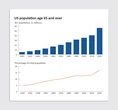On Monday, Starbucks rolled out a new dress code as part of its larger corporate overhaul. But union workers say the change is both restrictive and unproductive—and now, baristas are walking out.
The dress code comes as new CEO Brian Niccol is on a mission to bring the brand “back to basics,” including by scaling back its menu, returning hand-written notes on cups, and introducing ceramic mugs in stores. Employees are now required to wear a more simplified palette of solid black tops along with khaki, black, or blue denim bottoms under the company’s signature-green apron.
However, in an email to supporters, Starbucks Workers United—the union representing Starbucks baristas—called the dress code “restrictive,” adding that it was implemented “without input from the baristas it affects.” The union has been bargaining to reach a contract with Starbucks for over three years, with no end in sight. It says that the new dress code represents “bad faith bargaining,” alleging that the code undermines a tentative agreement about attire made at the bargaining table.
A spokesperson from Workers United told Fast Company that, as of Wednesday evening, walkouts have occurred at more than 100 Starbucks locations and included more than 1,200 baristas. The strikes come in the wake of a lackluster financial report for Starbucks’s second quarter of 2025, during which revenue dipped below expectations, U.S. comparable store sales declined 2%, and U.S. comparable transactions were down 4%—leaving some analysts wondering just how well Niccol’s “back to basics” plan is actually working.
Union workers are frustrated with the new dress code
According to a series of videos posted by Workers United, baristas are frustrated with the new dress code for a number of reasons.
In one clip posted to Bluesky, a group of workers at a store in Dallas claim they were told their black sneakers were no longer acceptable under the dress code, and that they would have to buy new shoes before returning to work. The Workers United spokesperson explained that, in the past, waterproof shoes have always been a requirement. On Monday, though, several workers (including those in the aforementioned video) claim they were told their waterproof shoes couldn’t have any mesh fabric, despite the fact that such a stipulation was not included in the new dress code.
As this new dress code begins to be enforced, Starbucks didn't provide money for new shoes. The company would rather understaff stores than let us work in the shoes we've always worn during shifts. Customers don't care about what's on our feet![image or embed]— Starbucks Workers United (@sbworkersunited.org) May 13, 2025 at 7:50 AM
As this new dress code begins to be enforced, Starbucks didn't provide money for new shoes. The company would rather understaff stores than let us work in the shoes we've always worn during shifts. Customers don't care about what's on our feet![image or embed]
The spokesperson also alleged that employees have been sent home for small details like the color of their blue jeans or the number of visible piercings.
“Managers are told that they have to enforce all these things; otherwise their own jobs are in jeopardy,” the spokesperson said. “It’s creating a lot of frustration and confusion, and making baristas feel like this really isn’t about what they’re wearing; it’s just about control.”
In another video of workers announcing their reasons for walking out, one barista shared: “Now we have to purchase new shirts and shoes to be compliant with the new policy. Why doesn’t Starbucks do the right thing and provide a stipend for these newly required items?”
View this post on Instagram A post shared by Starbucks Workers United (@sbworkersunited)
View this post on Instagram
A post shared by Starbucks Workers United (@sbworkersunited)
Starbucks announced its dress code change on April 14. At the time, the company said it was also launching a line of company-branded T-shirts, adding that employees could receive two of these shirts at no cost. However, the Workers United spokesperson said they’d received several reports of the free shirts not being ready for baristas on Monday. Starbucks, on the other hand, claimed that, of the 18 styles available, only three were temporarily unavailable in a few sizes this week.
In response to the recent walkouts, a Starbucks spokesperson said: “The biggest update to our dress code is simple: wear a black shirt—either your own or one we provide. While Workers United, which represents less than 5% of our workforce, attempted to create disruption in a handful of stores, the overwhelming majority of our 10,000 U.S. company-operated stores remain open and are serving customers as normal. ”
The spokesperson noted that there haven’t been any changes to the shoes baristas can wear, other than the heel height, adding that footwear can be black, grey, navy, brown, tan, or white. However, they did not comment on baristas’ complaints about the inconsistent application of the dress code.
The spokesperson added that it would be “more productive if the union would put the same effort into coming back to the table to finalize a reasonable contract. ”
A broader issue
Strikes due to the dress code are just the latest chapter in an ongoing battle between Workers United and Starbucks—and union members say their concerns go far beyond what they’re supposed to wear.
Over the past three and a half years, Workers United has been in a continuous bargaining process with Starbucks management, seeking a contract that includes higher wages, guaranteed hours, and better staffing in stores. Members reported that negotiations between the union and the company broke down in late February, which has led union members to increasingly engage in acts of civil disobedience, like sip-ins, walkouts, and picket lines.
In the past, both the union and the National Labor Relations Board (NLRB) have argued that Starbucks hasn’t been bargaining in good faith. In December, Workers United filed an updated unfair labor practice charge with the NLRB outlining their concerns around the drawn-out bargaining process. And, recently, the union filed a new amendment with the NLRB alleging failure to bargain over the dress code.
The amendment calls the dress code an example of “bad faith bargaining” for “unilaterally implementing a new dress code policy . . . that materially differed from both the status quo and what the parties had tentatively agreed to at the bargaining table.”
A Starbucks spokesperson said they would “make sure any differences between our negotiations and store implementations are addressed lawfully and fairly.”
Jasmine Leli is a barista from Buffalo, New York, who’s worked at Starbucks for three years. She’s also one of the union bargaining delegates who ran the dress code working group that led to a tentative agreement about a future dress code. The union’s proposed dress code, she says, included protections like allowing workers to wear union T-shirts to work and to keep their visible piercings. Leli calls the new dress code a “distraction from fixing the real issues that we have in our stores.”
“As partners, we don’t have guaranteed hours,” Leli says. “We don’t have enough people at work during the middle of the day and at night. I’m not getting all of the hours that I need. I’m not making a fair wage—I got a 30 cent raise—and now I’m being asked to go out and purchase a completely new wardrobe, including shoes, and our contract hasn’t been finalized.”
Ultimately, Leli says, Starbucks should be working to finish the contract and solve its staffing issue—not implementing a new dress code. Customers care more about the wait time for their latte than the shirt their barista is wearing, she adds.
“We’re more than mad because the changes that the company is making don’t address the issues that we’re facing in the stores,” Leli says. “Starbucks is iconic for their green apron. Customers know they’re walking into a Starbucks. It’s not a mystery. And with my regulars, I know their drink, and they know me, whether I’m in a purple shirt or a black shirt.”










No comments